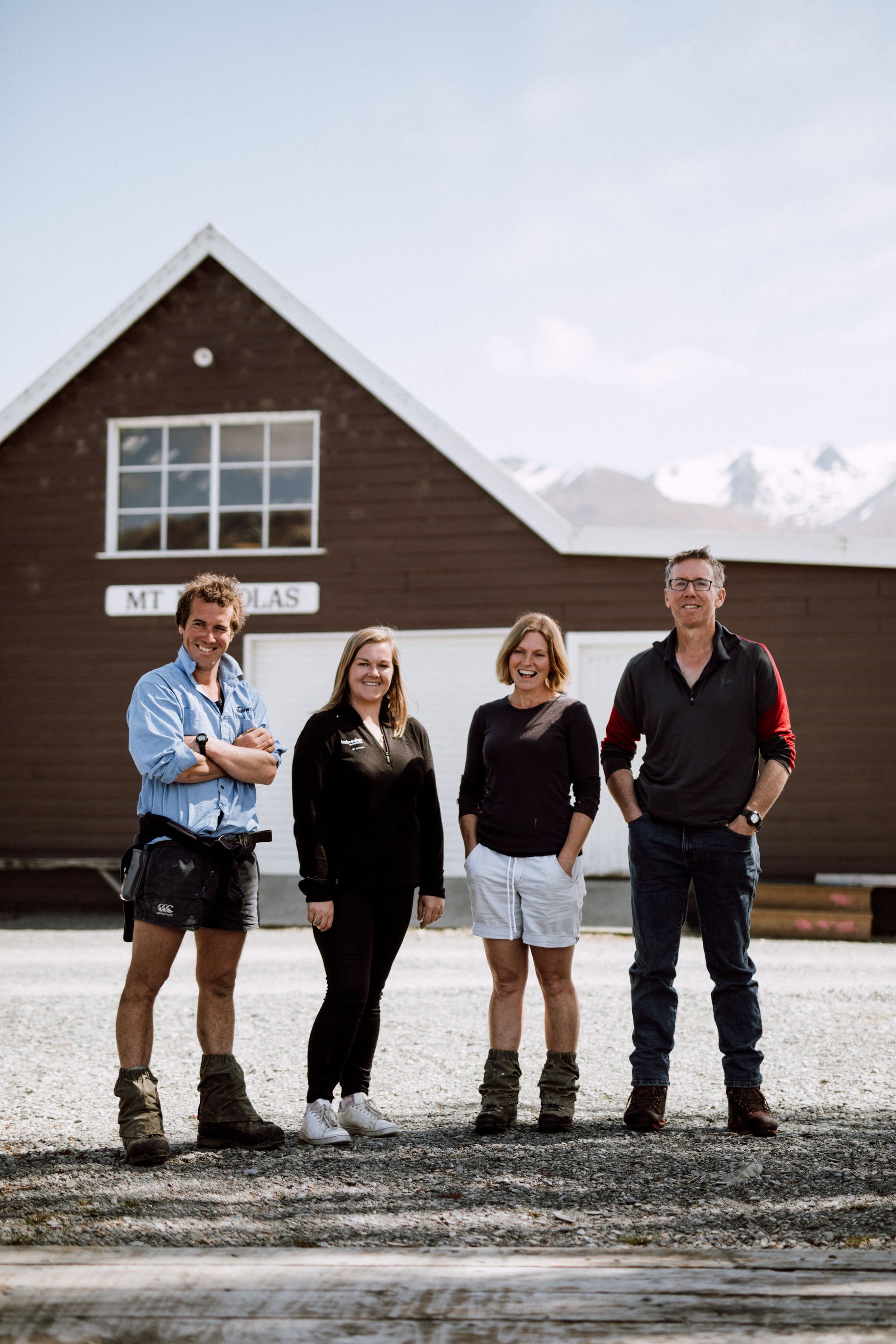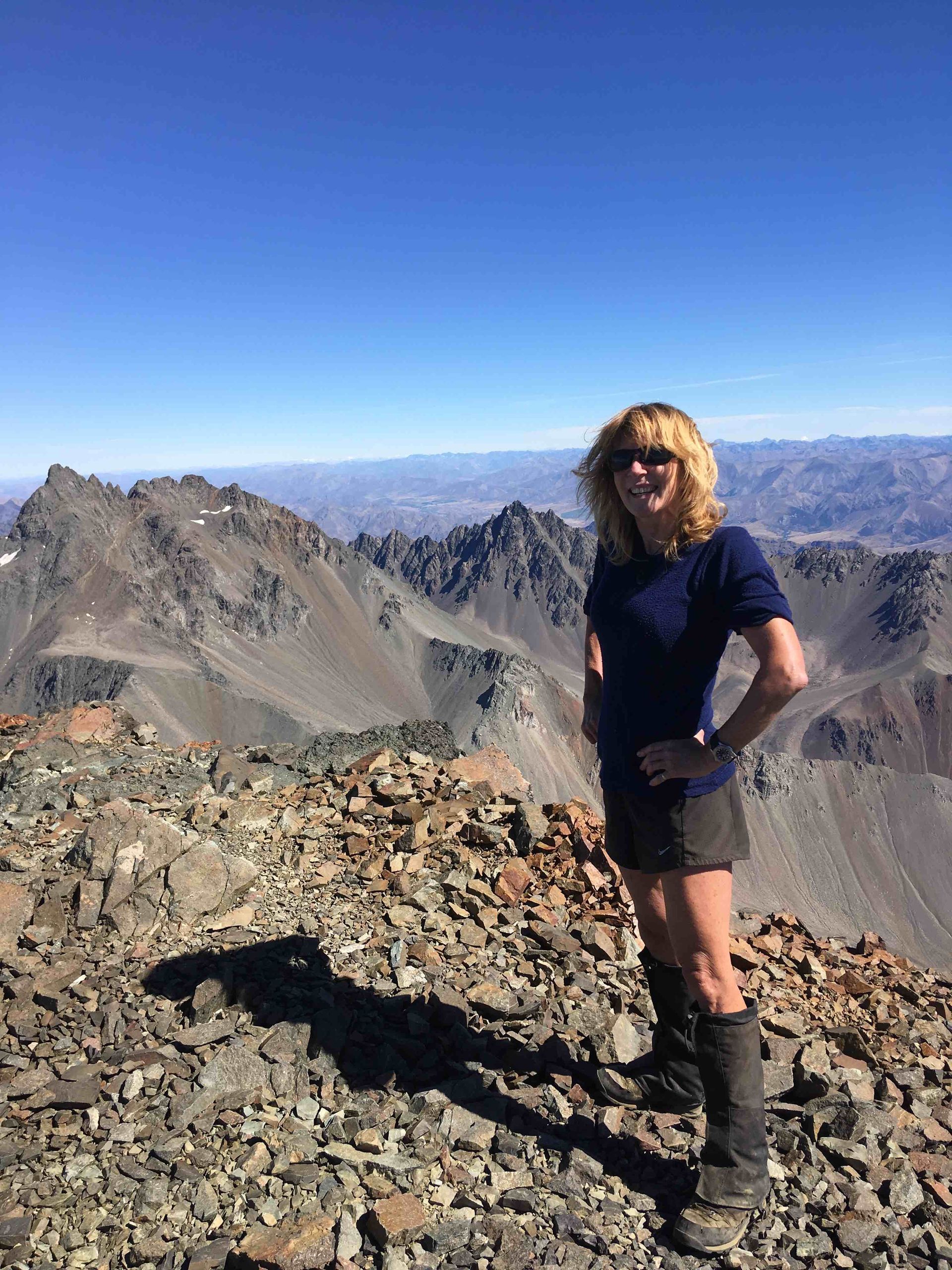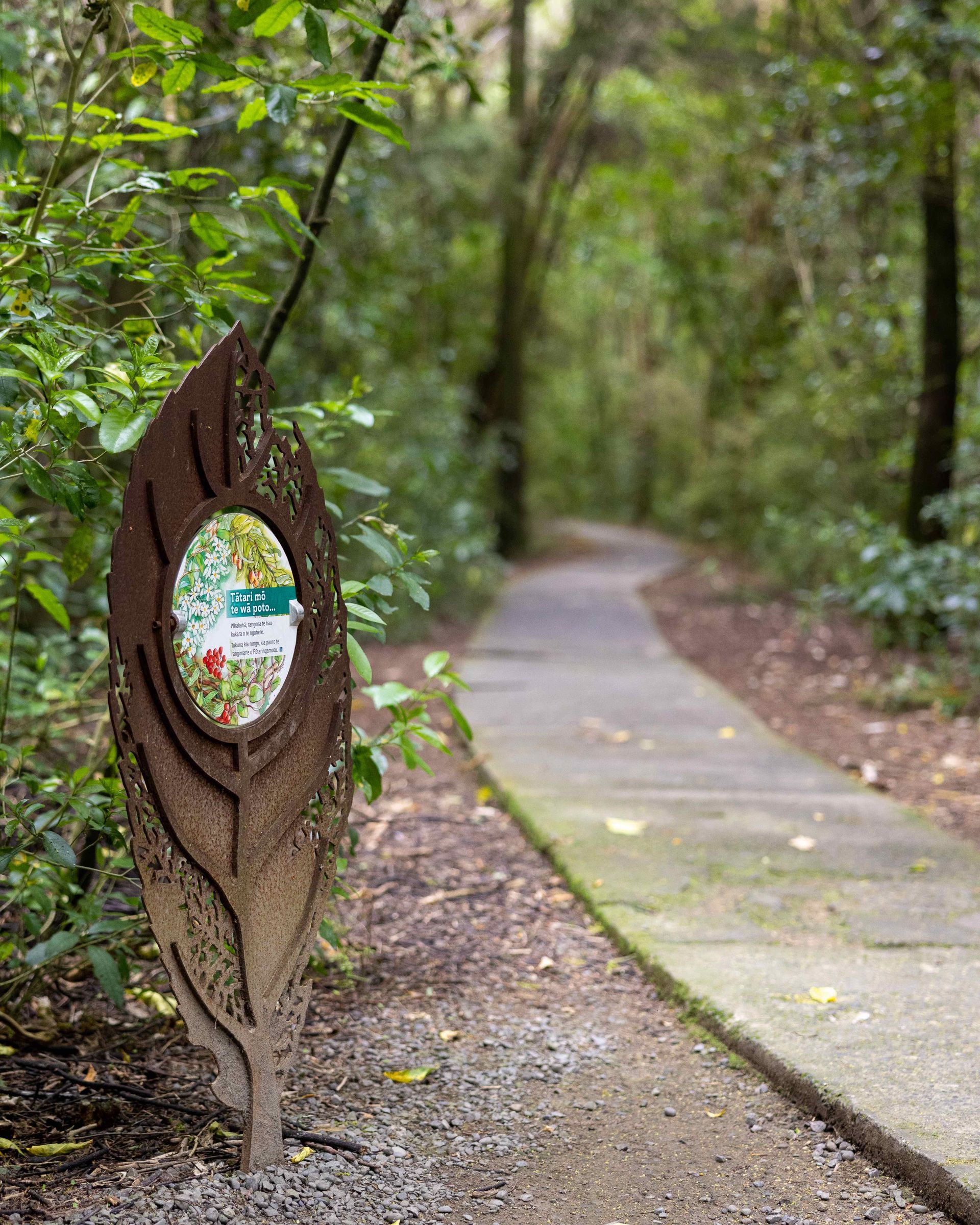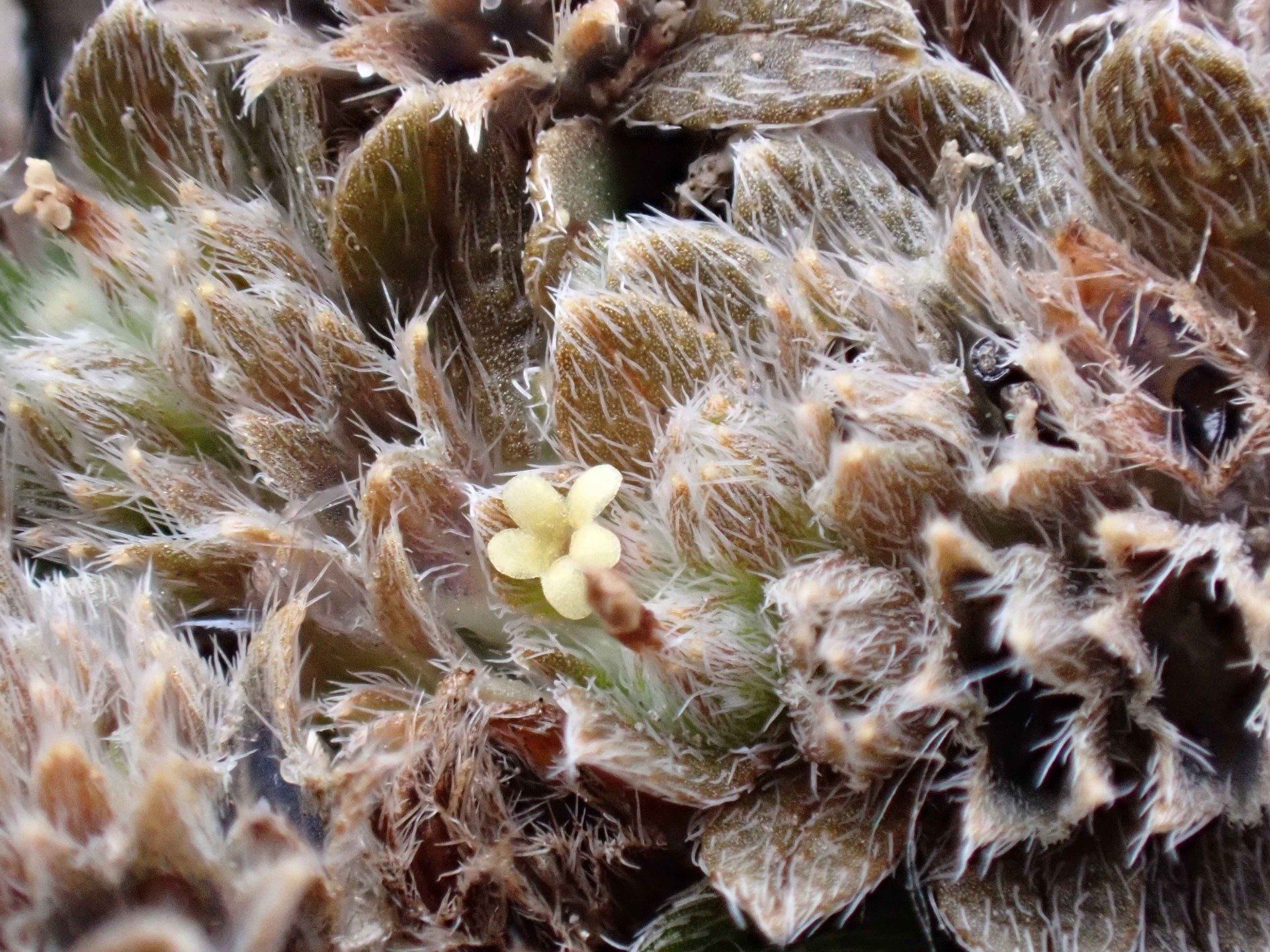Latest stories
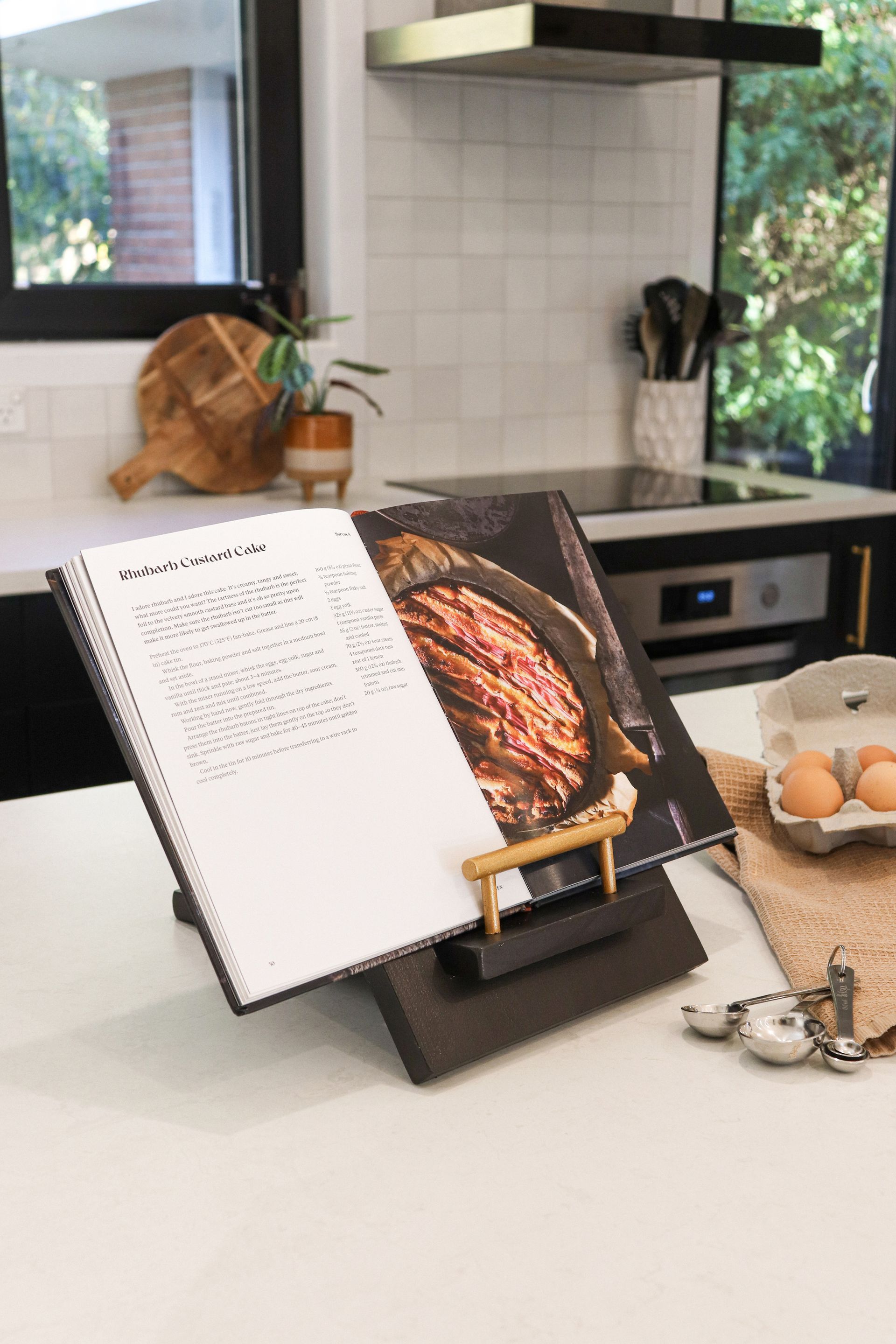
With its sliding base, this stand can snugly hold any recipe card, tablet or cookbook – no matter how chunky or slim. Choose your favourite colours to ensure it is the perfect match for your kitchen or as a great gift idea. Plus, when it’s not in use, you can easily store both parts flat! What you need: 1 x 300 x 230 mm sheet of pine board, 18 mm thick (backboard) 1 x 300 x 150 mm sheet of pine board, 18 mm thick (baseboard) 1 x 120 mm pine dowel, 12 mm thick 2 x 40 mm pine dowels, 8 mm thick Drill and drill bits Drop saw Drop sheet Jigsaw or reciprocating saw Measuring tape Paintbrush and mini roller Resene testpots – we used Resene Gold Dust and Resene Apache Resene Lustacryl semi-gloss waterborne enamel paint, tinted to your choice of colour – we used Resene Bokara Grey Resene Quick Dry waterborne primer Ruler Sandpaper Wood glue Step 1: Cut your wood to the sizes listed above. Step 2: Measure and mark out a 155 x 25 mm slot, positioned 40 mm up from the base of the backboard, as shown. Step 3: Drill a hole in each corner of the marked slot to give your saw a starting point. Then, use either a jigsaw or reciprocating saw to carefully cut out the slot. Step 4: Smooth out any rough edges with sandpaper. Step 5: To make the handle, drill two 8 mm holes in the 12 mm dowel. Each hole should be drilled three quarters of the way through the dowel, centred and positioned 20 mm from each end. Begin by drilling small pilot holes to guide the larger drill bit.
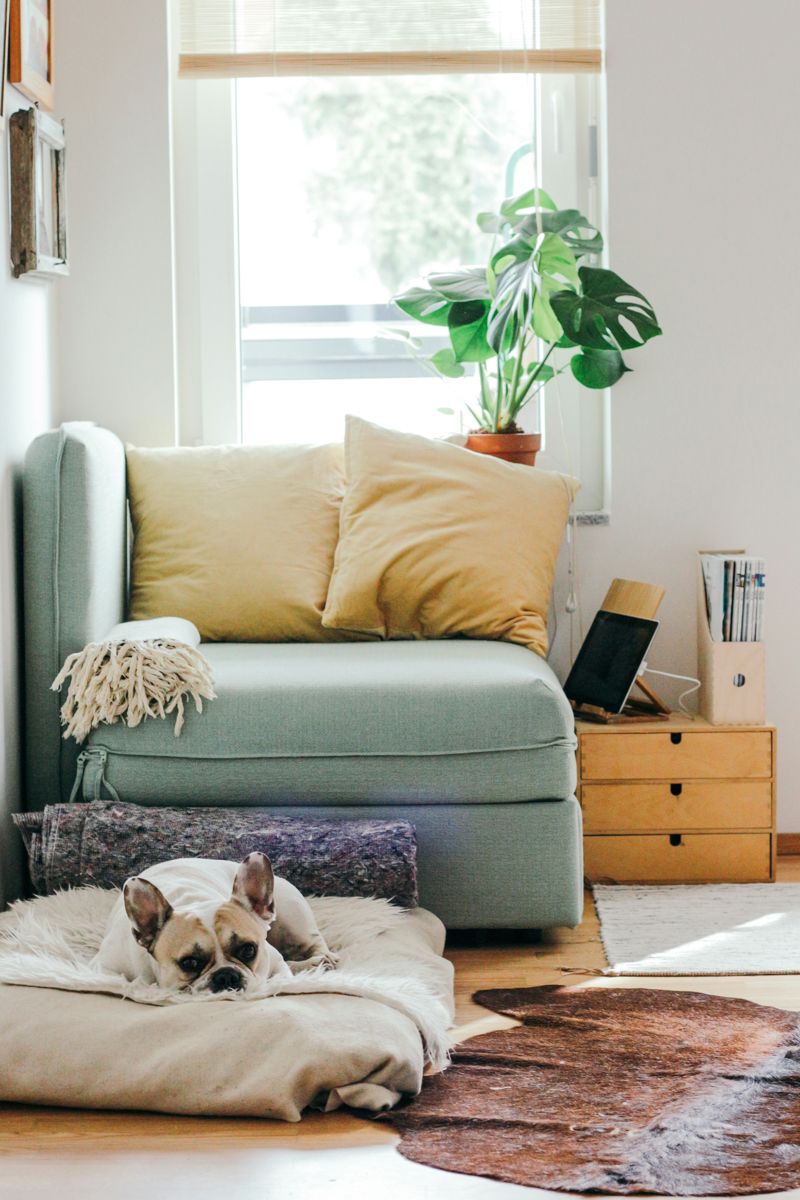
We are on the cusp of a once-in-a-decade influx of properties on the market. Nathan Miglani, Director of NZ Mortgages, explains. As we have discussed, in the aftermath of the election we saw immediate momentum in the market. Since March we have seen this start to drop as the reality of interest rates remaining high dampened buyers’ appetite. Petrol prices are high, the cost of living continues to increase and while the OCR is holding, and forecasted to hold for the next few months, people are hurting, which in turn sees the property market slow. But there is hope on the horizon – we are predicting that by September/October we will start to see interest rates slowly start to come down, but do not expect them to drop as quickly as they rose. We are seeing some banks offer as low as 5.99 per cent on a three-year loan, and while this might sound good now, my advice is still to only fix for a short term to avoid costly break fees. The most active market we are seeing right now is in the $800,000 – $1.3 million range with lots of buying and selling happening. This is set to ramp up come 1 July with the changes to the bright-line property rule when it comes to being taxed on capital gain – dropping from 10 years (or five years for a new build) to two. For many it will seem too good to be true, but it is! This is set to put in motion a once-in-a-decade influx of properties to the market from Mum-and-Dad investors who are currently hurting with the high interest rates, creating massive opportunity for both first home buyers and first-time investors. Other sectors of the market continue to feel the pinch and as an advocate and passionate developer it was important to me to be able to assist the construction sector, which sees the launch of our construction division, Construction Loans. This is for those who have decided to build their first home, right up to those developing a subdivision. It is about helping everyone achieve their goals – which underpins everything we do. For this sector, it is about ensuring that the finances are in order before it is too late. Arranging finance for building a property is different from securing finance on an existing home, and it is critical to consider the best way to structure repayments on the section and the build while maintaining lifestyle. It is about empowering builders, developers and everyone to make informed decisions that work for their unique situations. There is no one size fits all, which is why it is imperative that you seek professional advice before it’s too late. We are here to help you avoid pitfalls.

Dr Cheryl Doig explores why a holistic approach, when it comes to educating, parenting and governing should be considered. It’s a complex world that our young people are growing up in. Societal change, the impact of social media and technology are colliding with climate change, misinformation, disinformation, and warfare. Trust in governments has deteriorated and the world is more polarised. It’s no wonder wellbeing and happiness are such a focus in our schools, our homes and our businesses. The recent results from the 2024 Global Happiness Index showed that happiness in Aotearoa New Zealand has fallen significantly for all age groups, but by twice as much for the young as for the old. In 2021–2023, our young people were the least happy age group. Females under 30 have one-third more negative emotions than males. Our young people are not thriving. Contrast this with 2006–2010 results, when the young were happier than those in the midlife groups, and about as happy as those aged 60 and over. The Anxious Generation: How the Great Rewiring of Childhood is Causing an Epidemic of Mental Illness by Jonathan Haidt provides some insight into what might be happening here. Haidt refers to our young people as ‘the anxious generation’ and outlines the following as contributing factors: Technology – constant connectedness and the facade of always appearing happy and successful on social media. The cult of safety – overprotective parents and risk aversion – not developing resilience nor the ability to cope with challenges. The loss of play – the decline of unstructured play and outdoor exploration, critical factors for social, emotional and cognitive development. The pressure to succeed – intense academic and extracurricular expectations. The loneliness epidemic – social isolation is more prevalent even though our children appear more ‘connected’. These are deep social issues that have no simple solution. What is needed is an holistic approach to parenting, educating and governing. A focus on literacy, numeracy and sciences alone is not going to lead to a wellbeing economy. Supportive relationships and acceptance of diversity matter more than ever. Creative and critical thinking, play and physical exercise cannot be forgotten. Futures thinking is one way of developing resilience, risk taking and autonomy, as it explores alternative world views and encourages anticipating a range of scenarios. Many of our teachers know this but struggle with the ever-changing pendulum swings of successive governments. They’re exhausted and not so happy in their work. Schools need that sense of community support. We are overdue for a bipartisan collective vision for education in order to create a future where our young people thrive, are hopeful and happy. It’s not all doom and gloom. We can make a positive difference! As parents, whānau and communities, my challenge to you is to consider one item from the bullet point list above. Lean into it and give your children a bit of space to be children and have joy in their lives. Don’t crowd them, cosset them and control them so much. Walk alongside and guide them. Let them learn from failure with you as their coach. Celebrate successes.

Whatever your work situation, here are some valuable insurance tips to help safeguard your home office. Kiwis love the flexibility of working from home, with Stats NZ reporting four out of five businesses offered flexible working arrangements in 2023. For the start-ups and sole traders though, this is nothing new, with many great businesses founded in garages, sheds or spare rooms. Whatever your work situation, here are some valuable insurance tips to help safeguard your home office. Check your current cover While homeowner’s insurance might provide some coverage for personal property, it may not extend to business-related equipment or liabilities. Check that any sub-limits meet replacement costs, especially for electronic equipment, and remember to keep your broker or insurer up to date with any new purchases to ensure your sum insured is adequate. Explore home-based business endorsements Some homeowner’s insurance policies offer endorsements or add-ons for home-based businesses. These endorsements can enhance your coverage by extending protection to business-related property and liabilities. Check with your broker or insurer to see if this is an option for you. Consider business insurance A recent Insurance Council of New Zealand survey reported only 38 per cent of homeowners have business insurance to cover their home-based businesses. Whether you’re a consultant, freelancer or entrepreneur, a comprehensive business insurance policy tailored to your unique situation can safeguard your equipment, inventory, and liabilities associated with your professional activities in a way homeowner’s insurance can’t. Liability protection From client meetings to product deliveries, your home workspace may expose you to various liabilities. Liability insurance provides crucial protection against potential lawsuits or damages arising from accidents or injuries that occur on your property, or errors and omissions in your work. It’s a vital component of your risk management strategy, offering financial protection and legal support when you need it most. Cyber security Cyber threats pose a significant risk to businesses of all sizes. Ensure you have adequate cyber security measures in place and consider investing in cyber insurance to protect your business against data breaches, cyberattacks and other digital risks. This coverage can mitigate financial losses and reputational damage stemming from cyber incidents, safeguarding your business continuity. Get professional advice Partner with an experienced insurance broker to ensure your home-based business and your future livelihood is protected.

New Zealand is nine months into the roll-out of a new cervical screening programme which includes a self-swab as an initial step. Dr Pip Shirley explains how this simple test aims to reduce cervical cancer cases. Together with other nations, we’re working towards an ambitious goal developed by the World Health Organization, the ‘90–70–90’ target, as we informally call it. It states that by 2030: 90% of girls should be fully vaccinated against HPV (Human papillomavirus) by age 15 70% of women should be screened using a high-performance test by age 35 and again by 45 90% of those identified with cervical disease should receive appropriate treatment So how is New Zealand going? Our national target is for 75% of young people to be fully vaccinated against HPV – ideally before their first sexual encounter. But, as of July 2023, only about 57% of 13–14-year-olds had been vaccinated. There is a strong link between HPV, which is incredibly common, and cervical cancer. That is why vaccination is such an essential preventative measure. Cervical cancer starts in the cells lining the cervix. It is triggered by cell changes caused by infection with HPV, so the second line of defence after vaccination is screening for HPV. In the past, cervical screening has involved a speculum examination and a cervical smear. The National Cervical Screening Programme now offers the option of a vaginal swab test first. This can be carried out by your GP or practice nurse, at a Māori, Pacific or women’s community health centre, at a Sexual Wellbeing (formerly Family Planning) clinic or at an outreach service, like marae and mobile units. Self-testing is an option, and some providers may offer a take-home test. Most test results (about 90%) come back normal. If a result comes back abnormal, the traditional smear test will be taken, followed by a colposcopy if needed. A colposcopy is an examination where a speculum is placed into the vagina and then a microscope is used to magnify the cervix. Two solutions are applied to the surface of the cervix to help identify any abnormalities. These can then be diagnosed further by taking a biopsy. Timetoscreen.nz has excellent plain language information for further reading. 85% of New Zealand’s cervical cancer sufferers have either never been screened or not opted for regular screening. We must do better. If a smear is required, it is important to know that your gynaecologist and colposcopist understand the discomfort. Examinations are performed with utmost respect and we try to ensure they are as tolerable as possible. If it helps you to feel better prepared, consider asking for an initial appointment to discuss the process first. You are also welcome to bring a support person. Remember that the purpose of screening is to review people with no symptoms to identify those who need to be offered early intervention and reduce adverse outcomes. The more people who participate in cervical screening, the more quickly we can identify those at risk of cervical cancer.

In Orbell Street, Sydenham – once a hub for textile manufacturing in Ōtautahi Christchurch – most of the knitwear factories have long since closed. One of the last remaining is Weft Knitting Company. We meet the company’s tenacious founder Hugh Douglas, whose influence and impact extends well beyond the factory walls. Early 2023, news stories began popping up about a Canterbury clothing company sending warm merino garments and underwear to war-torn Ukraine to help give comfort to Ukrainian soldiers. Weft has been on my radar ever since, and I am delighted to have secured today’s interview with company founder Hugh Douglas. Arriving at Weft’s premises, I am greeted by a trim 70-year-old who looks much younger than his years and has plenty of energy to boot. ‘This place is what keeps me going,’ he says, after politely dismissing the idea there could be a quiet retirement up ahead. ‘This is what gets me up in the morning and keeps me motivated. At age 70, I’ve still got 20 active years to go in business with the support of my family.’ He’s been at the helm of Weft for more than four decades, steering the business through various marketing and production challenges with trademark focus and determination. The company was an early adopter of advanced wholegarment knitting technology, and the introduction of merino wool/possum fur blends from the late 1990s proved another astute move. Over the past six years, there has been a large investment in new knitting technology. Faster knitting times, as well as bringing in more wholegarment machines, has helped keep the business competitive. Weft’s brands include luxury Noble Wilde Knitwear, Bay Road Merinos, and a thermal wear range of Thermerino and Thermadry undergarments. Weft sells into both New Zealand and offshore markets. ‘Weft’s exports to the UK and Europe have increased steadily over the last 16 years, thanks primarily to our New Zealand sales and marketing manager and our European sales manager, based in London,’ explains Hugh. As we chat, it becomes clear that Hugh cares deeply about his staff and is always ready to give support when needed, for example with financial budgeting. ‘What people don’t necessarily appreciate is that Weft is not a sweatshop; we’re providing good long-term careers for skilled Christchurch people. I like to lead by example: I am hard-working, I know all my 73 staff by name. They are my extended family, and myself and my management team are always concerned about their wellbeing.’ The depth of that connection becomes obvious when we take a walk around Weft’s extensive factory floor and warehouse premises, where we meet staff members like Ukrainian paediatrician Iryna Pershakova, who came to New Zealand to join her son almost two years ago and is very grateful to have found a safe refuge here. Alongside her work in the factory and ongoing English classes, she makes traditional dolls to fundraise for children’s hospital care in Ukraine. We also meet Rob Harris, who started at Weft as a 15-year-old and is still with the company 13 years later. ‘Hugh is a great man,’ says Rob, noting how Hugh has always gone the extra mile for him. ‘I don’t think people realise how big his heart is.’
Health + Wellbeing

New Zealand is nine months into the roll-out of a new cervical screening programme which includes a self-swab as an initial step. Dr Pip Shirley explains how this simple test aims to reduce cervical cancer cases. Together with other nations, we’re working towards an ambitious goal developed by the World Health Organization, the ‘90–70–90’ target, as we informally call it. It states that by 2030: 90% of girls should be fully vaccinated against HPV (Human papillomavirus) by age 15 70% of women should be screened using a high-performance test by age 35 and again by 45 90% of those identified with cervical disease should receive appropriate treatment So how is New Zealand going? Our national target is for 75% of young people to be fully vaccinated against HPV – ideally before their first sexual encounter. But, as of July 2023, only about 57% of 13–14-year-olds had been vaccinated. There is a strong link between HPV, which is incredibly common, and cervical cancer. That is why vaccination is such an essential preventative measure. Cervical cancer starts in the cells lining the cervix. It is triggered by cell changes caused by infection with HPV, so the second line of defence after vaccination is screening for HPV. In the past, cervical screening has involved a speculum examination and a cervical smear. The National Cervical Screening Programme now offers the option of a vaginal swab test first. This can be carried out by your GP or practice nurse, at a Māori, Pacific or women’s community health centre, at a Sexual Wellbeing (formerly Family Planning) clinic or at an outreach service, like marae and mobile units. Self-testing is an option, and some providers may offer a take-home test. Most test results (about 90%) come back normal. If a result comes back abnormal, the traditional smear test will be taken, followed by a colposcopy if needed. A colposcopy is an examination where a speculum is placed into the vagina and then a microscope is used to magnify the cervix. Two solutions are applied to the surface of the cervix to help identify any abnormalities. These can then be diagnosed further by taking a biopsy. Timetoscreen.nz has excellent plain language information for further reading. 85% of New Zealand’s cervical cancer sufferers have either never been screened or not opted for regular screening. We must do better. If a smear is required, it is important to know that your gynaecologist and colposcopist understand the discomfort. Examinations are performed with utmost respect and we try to ensure they are as tolerable as possible. If it helps you to feel better prepared, consider asking for an initial appointment to discuss the process first. You are also welcome to bring a support person. Remember that the purpose of screening is to review people with no symptoms to identify those who need to be offered early intervention and reduce adverse outcomes. The more people who participate in cervical screening, the more quickly we can identify those at risk of cervical cancer.
Food + Drink
Rural
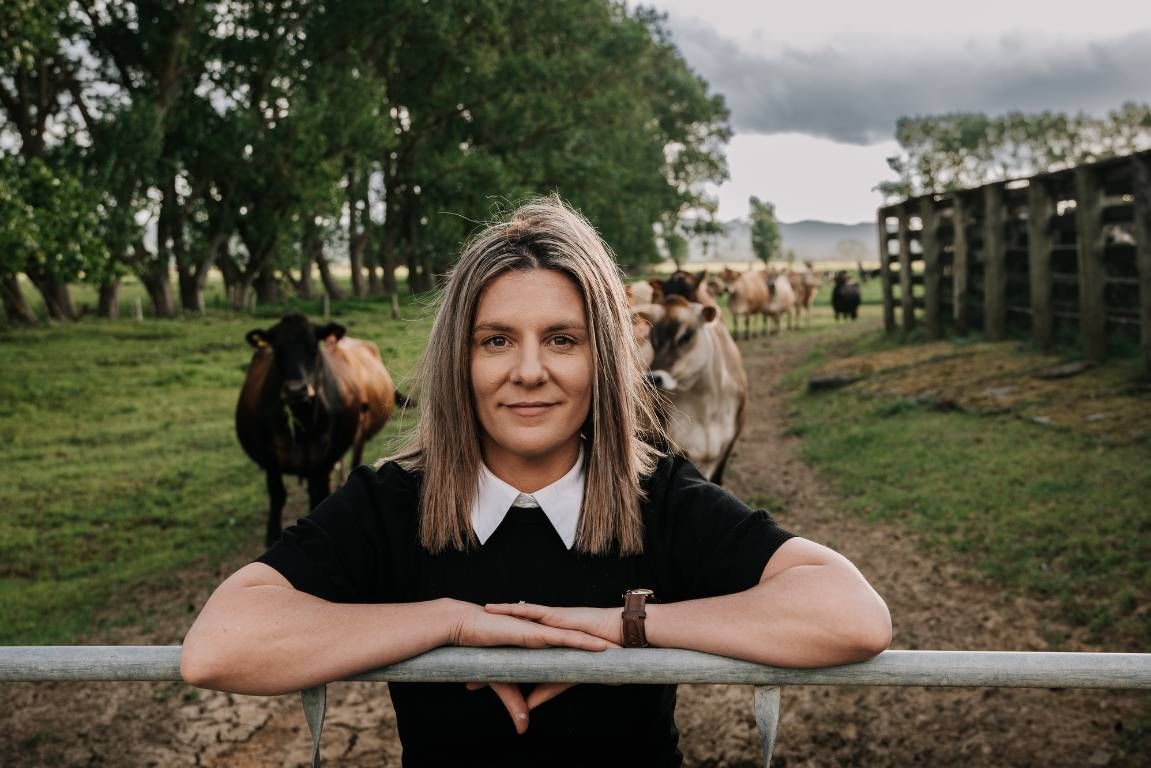
The thought of your loved one lying in the ditch in the dark, pinned down under a quad bike, drifting in and out of consciousness waiting for help is a common fear of many with family, friends and colleagues working on-farm in New Zealand. A recent campaign to curb the ‘she’ll be right attitude’ has emerged at a crucial time for farmers under pressure.










